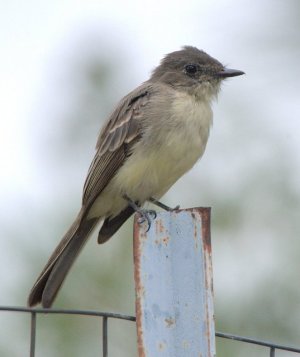To refresh your memory, here is the photo from September’s Bird Quiz. The bird was seen in Colorado during the month of September. Don’t read any further if you want one last chance to identify this bird.
 If you identified last month’s bird, you have a head start on this one. (If you didn’t see August’s bird quiz, the answer and explanation are here.) But even if you missed last month, there are several clues that tell us where to begin.
If you identified last month’s bird, you have a head start on this one. (If you didn’t see August’s bird quiz, the answer and explanation are here.) But even if you missed last month, there are several clues that tell us where to begin.
At first glance, this bird is pretty nondescript. There are no bright colors, no wing bars or eye ring, in fact, there are no unique shapes or features at all—or are there?
The classically shaped bird is clearly perched on a small branch, which gives us an idea of its size—relatively small. The shape, size, and behavior are good clues that this is a Passerine songbird. We’ve just eliminated half the birds in the field guild.
Next, since this is a close-up, take a look at the beak. It has thin feathery strands around it. Not all birds have those. Why would a bird need “feelers” near its beak? Would they help it sense its prey? In fact, feelers like these would be really helpful at telling the bird when there’s a fly within range, so it could catch it. Hmmm… could this be a flycatcher?
What kind of flycatcher do we have? I went into considerable detail about the different flycatcher genera last month. If you need a refresher, you might want to click over and reread those paragraphs. I’ll just summarize here:
Kingbirds are large, sturdy birds with impressive bills, a black band through the eye, and often with bright to pale yellow undersides. Myiarchus flycatchers are also larger birds with yellow underneath, and rust on their tails and/or secondary flight feathers.
Phoebes are mid-sized between the larger kingbirds and the smaller Empids and pewees.
Empids are small with distinctive eye-rings and two prominent white wing-bars. Some of the pewees (in the genus Contopus) are easily confused with the Empids. However, they’re slightly larger, with longer wings. They don’t flick their tail as the Empids do, and they come in slightly darker shades of gray. They tend to sit at attention, with an erect, upright posture.
If you check in the field guide, you can immediately eliminate the kingbirds and Myiarchus flycatchers. Our bird is too small and too dark. It’s clearly not one of the phoebes either.
That leaves the Empids and the pewees. We can quickly cross off the Greater Pewee, as those have a crest like that of a titmouse, Blue Jay, or Northern Cardinal. So this bird is either an Empids or one of the three remaining species in the genus Contopus: Olive-sided Flycatcher, Western Wood-Pewee, and Eastern Wood-Pewee.
First, we can eliminate the Empids (thank goodness). Sibley explains that:
Both wood-pewees are distinguished from all Empidonax flycatchers by longer wings, long primary projection, and relatively short legs; also by dark face with weak partial eyering, dusky “vest,” and grayish smudges on undertail coverts.
Our bird has a dark face and no easily discerned eye-ring. Its chest is dark, much darker than an Empid would have. In fact, the “vest” is dark enough that it looks more like a bib, but this is a relatively dark bird to begin with. The angle of the bird in the photo means we can’t see how long the wings are. Its posture is quite erect, however. The field marks all point to a bird in the genus Contopus.
It could be an Olive-sided Flycatcher. They’re larger than the two wood-pewees, but we can’t determine exact size from this photo. Happily, this individual is making things easy for us. Olive-sided Flycatchers have a white breast peeking out between the two sides of their “vest.” Pewees often do too—they’re quite variable—but our bird happens to be uniformly dark across the front. It’s not an Olive-sided Flycatcher.
So we have a wood-pewee—but which one? Knowing that the photo was taken in Colorado, the most likely candidate is the Western Wood-Pewee, but Easterns do show up here on occasion. The songs differ, but even if I had included a recording, it wasn’t singing in September.
If you look in a field guide, the Western Wood-Pewee’s wing bars aren’t as bright as its eastern cousin, and the birds are often drawn a bit darker, but they are variable enough that these field mark aren’t conclusive. In fact, according to the Cornell Lab of Ornithology, the only sure way to tell these two species apart is by their song. (I know some excellent birders who wouldn’t hesitate to ID a bird as one or the other, but I’m not that experienced!)
So where does that leave us? This is probably a dark Western Wood-Pewee, but I”m not 100% sure. Kinda frustrating, isn’t it?
Here are a few more wood-pewees photographed in Colorado:



I just love these posts where you take us step by step through the ID process. Thanks!
Greeat read thankyou